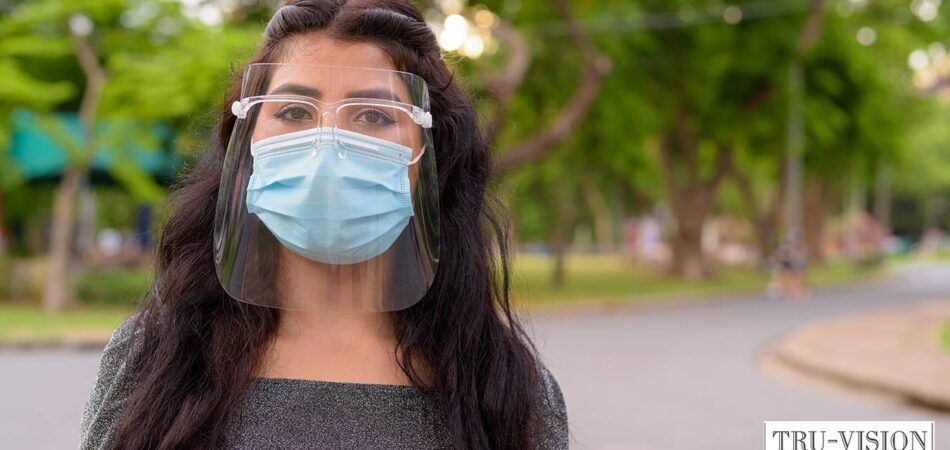
A face shield or visor is a type of personal protective equipment (PPE) worn to protect a person’s eyes, nose, mouth, and facial skin from infectious fluids or flying debris and caustic liquids. Face shields made from special plastic compounds can also protect the face from extreme heat or arc flashes experienced by welders. Face shields are easy to clean, may be reused several times as long as they are not damaged in any way, and are more comfortable to wear than KN95 or N95 masks. In hospital or lab settings where workers are constantly exposed to airborne pathogens and body fluids, PPE protocol recommends wearing a face shield and a NIOSH-approved mask.
How Long Can You Use One Face Shield?
As long as the face shield is not cracked, warped, or damaged enough to reduce protective factors, you should be able to continue using the same face shield. Never attempt to repair tiny cracks with epoxy glue or superglue or place duct tape over small cracks. Just one crack, regardless of how small it is, will significantly diminish the integrity of the face shield. Plastic compounds that make face shields are designed to maintain superior strength and unyielding non-porousness against objects and fluids like a solid matrix. Any minimal defects in the face shield will put the wearer’s health at risk.
When Should You Change Your Face Shield?
Inspect your face shield every time you wear the visor. Examine it before you put it on and after you take it off. People who work in industrial settings should inspect their face shields in a sufficiently lighted area so they can more easily find cracks, nicks, or dings. Although you might not have felt or noticed an object hitting the visor, a minuscule piece of metal can strike the visor and leave a scratch or even a crack.
Face shields made of polycarbonate, PETG, or other materials are not shatterproof. That’s why it is essential for your safety that you change a face shield whenever you discover the slightest defect in the visor. Face shields that no longer extend below your chin, reach your ears, or eliminate any gaps between the headgear and your forehead should be discarded and replaced with a new face shield. Structural damage to a face shield visor poses the same health risks as surficial damage. However, if a face shield does not seem to cover the face appropriately, always check the headgear for signs of possible defects that could cause misalignment of the visor.
Can You Clean a Medical Face Shield and Reuse It?
Yes, face shields can be cleaned, sterilized, and used again as long as they are not damaged and fit appropriately over and around the face. The CDC recommends these instructions to clean medical-grade face shields:
- While wearing disposable gloves, saturate a clean cloth with a neutral detergent. Also referred to as anionic detergents, neutral detergents are soapless detergents made using weak acids and strong alkalis, such as hydrogen fluoride and alkylbenzene sulfonates. Neutral detergents work well to remove dirt, dust, and other particulates.
- Wipe the inside of the face shield with a neutral detergent cloth.
- Next, wipe the exterior of the visor with a clean cloth soaked in a disinfectant solution registered by the EPA.
- Continue cleaning the outside of the visor using a towel and rubbing alcohol to wipe off the residue.
- Let the face shield air dry completely or dry the shield using an absorbent, clean towel if you need to wear the shield as soon as possible.
Cleaning a medical-grade face shield with antibacterial wipes not only leaves a filmy residue on the visor but may also not kill viruses or resistant bacteria. Using 70 percent isopropyl alcohol to clean them is not recommended due to possible residue build-up.
Following either the CDC’s guidance or the manufacturer’s instructions for cleaning the face shield should allow you to wear the same medical-grade face shield again without compromising your safety or the safety of others.
Can You Clean and Reuse Workplace Face Shields?
Workplace face shields can be cleaned and reused as long as they are not damaged. Most industrial facilities have protocols in place for employees to follow regarding face shield cleaning. One of the most common plastic compounds used to make workplace face shields is a thermoplastic polyester called PETG. PETG face shields can also be sterilized when necessary, offering excellent strength and high chemical and impact resistance.
Can You Reuse Face Shields Worn in the Home?
People wear face shields at home for various reasons, ranging from barbecuing outside to woodworking to repairing family vehicles. When you wear face shields at home, it is typically to protect against minimal hazards. In this case, a tiny crack or other slight damage does not preclude you from reusing face shields to perform tasks at home, in the garage, or while doing yard work.
To clean a personal use face shield:
- Submerge the visor in a sink of soapy, warm water.
- Wipe off the front and back of the shield with a soft sponge.
- Don’t use an abrasive cleaner that could scratch the visor and reduce visibility.
- Rinse the face shield after cleaning and dry it with a microfiber towel to avoid leaving behind lint.
Clean and dry the visor’s headpiece separately to ensure each piece gets cleaned thoroughly.
Contact Tru-Vision Plastics, Inc. for All Your Face Shield Needs
Tru-Vision Plastics, Inc. is acknowledged by leading industries in the U.S. for manufacturing high-volume, superior-quality OEM face shields and aggregate blasting lenses sold through numerous safety distribution companies. We provide customized face shields for every need and environmental condition dependably and affordably. Call today to learn more about our personalized services.

22 Trackbacks